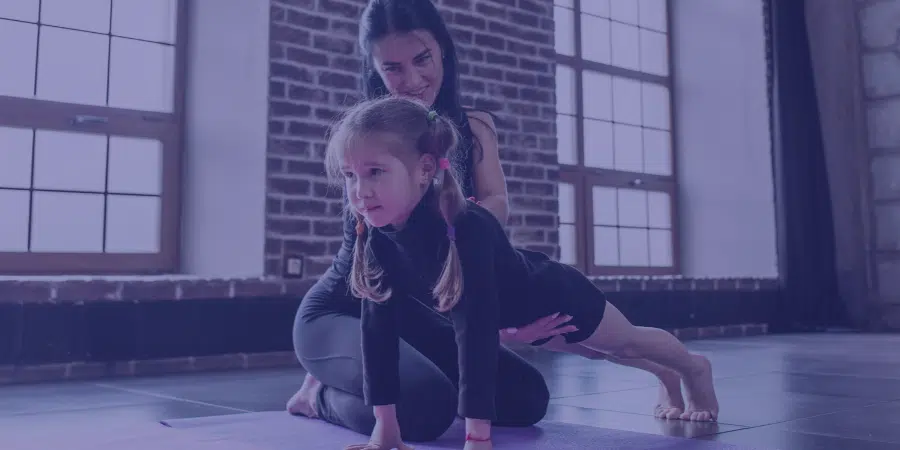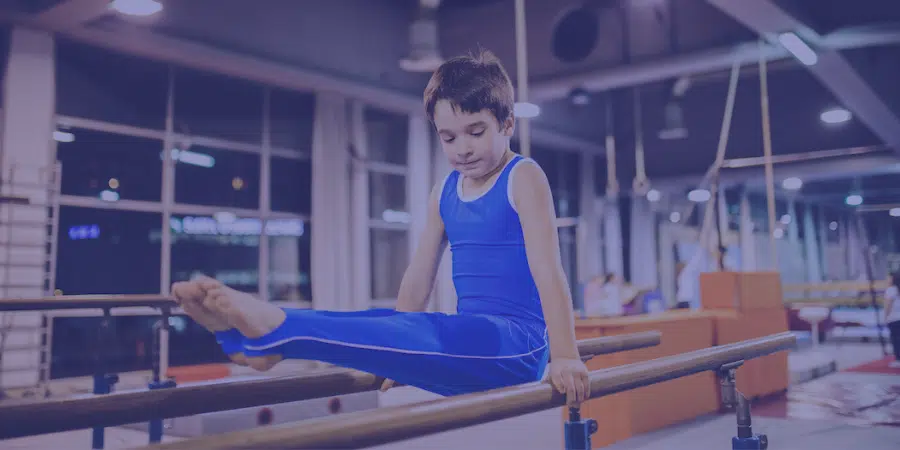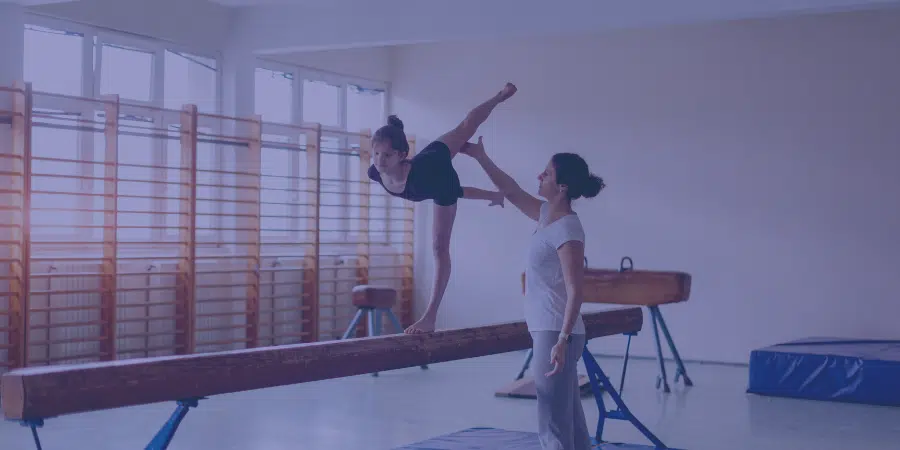Gymnastics is more than a sport. It’s an art form that is good for the mind, body, and soul. There’s nothing quite like the feeling of perfecting a routine or maneuver after weeks of hard work. Gymnastics for kids, in particular, can boost self-esteem and help them stay active. If you’re wondering how to teach gymnastics to kids at your gym or studio, it’s time to develop a plan. Here’s how to make the experience easy for you and exciting for your students.
Why Are Gymnastics Classes For Kids So Important?
Gymnastics requires strength, balance, and flexibility. For kids, these are important skills that transfer over to any sport. These skills help them have better control over their bodies, which can help reduce the risk of future injury.
The benefits of gymnastics extend far beyond physical advantages though, as we discussed in our earlier post. By nature, an activity like gymnastics requires self-discipline and patience. It isn’t an easy sport to master. Students must be diligent about practicing through setbacks and disappointments. This is why gymnastics classes for kids also build character.
Mentally and physically, gymnastics provides a great structure for kids to explore. This is how you can provide this service to kids at your studio or gym.
What You’ll Need To Teach Gymnastics For Kids
Maintaining a safe gym is essential when it comes to gymnastics for kids. You’ll need a fairly large space with the right floor. For tumbling and extensive routines, it’s best to have spring flooring that provides gentle bounce-back when your gymnasts stick a landing. If you aren’t ready for this type of financial investment, you can purchase mats of varying thickness levels to provide a soft surface for basic floor maneuvers.
In addition to flooring, balance beams and bars are a staple in most gyms. Consider purchasing a floor beam for your beginners, as well as a traditional lifted beam for intermediate to advanced students. Gymnastics bars also come in various levels. Many of them can even be adjusted for versatility. Many gyms also have trampolines, both large and small. These can be helpful when practicing jumps.
Finally, consider investing in a great webcam for your gym. This will allow you to teach classes online or even record videos for social media. It’s always helpful for students to be able to practice simple routines at home. Mount your camera on a stand or somewhere on the wall with a clear, wide-angle view. Include some general safety tips at the start of each session or video and then you can get started!

Develop Your Gymnastics Routine For Beginners
Like any other sport, warming up is an important part of how to teach gymnastics to beginners. Start your class with a series of stretching and lengthening exercises. Throw in a few jumping jacks, push-ups, and a quick jog around the building to get the blood pumping! Make this part of class fun by adding music.
After they’ve warmed up, these are some of the basic moves you can teach beginner students. Only tackle one or two moves per class. Remember, practice makes perfect and safety is always your number one goal!
Rolls
One of the most basic elements of gymnastics is a forward roll. While it may seem simple, a perfect form is key to mastering this move.
After the forward roll, teach them how to do a backward roll.
Cartwheel/roundoff
A cartwheel is a sideways rotary movement of the body that is widely considered another core component of gymnastics.
Roundoff is very similar, but they will land with both feet together.
Single balances
Balance is one of the most important features of gymnastics for kids. Teach proper form for a multitude of single balance moves, including a halfway stand, plank, bridge, and ankle hold.
These individual moves are utilized often throughout any gymnastics practice, regardless of experience level. It pays to introduce these from the beginning.
Jumping and landing
Any gymnast knows the importance of sticking your landing. By landing on your toes and bending your knees, you’ll land firmly planted on the ground.
Use a sturdy box or another elevated surface, as well as a mat, to teach your students how to jump and land safely.
Balance beam/bars
While balance beams and bars may seem more advanced, it’s important for your students to get familiar with this type of equipment.
Use a practice beam on the floor to promote simple balance exercises. For bars, keep them low to the ground and encourage your students to simply practice hanging for a few seconds (or attempt a pull-up).
Get The Word Out
Ready to spread the word about your new gymnastics classes for kids? You don’t have to spend a fortune on marketing. There are many fun and authentic ways to recruit more students.
Here are a few ideas to help you get started.

Use social media
One of the best free marketing tools is right at your fingertips. Facebook, Instagram, and YouTube are helpful for keeping in touch with current students, as well as finding new ones!
Share useful gymnastics statistics or tips in addition to your class information to reach new students.
Host an open house
Give potential students a glimpse of what you have to offer! An open house is a great way to show everyone what your classes are really like.
Make your open house more fun by building on a theme or doing a few giveaways along with it.
Post fliers
Find community boards at your local coffee shops, daycares, and schools. These are a great place to post your flier for everyone to see.
Include your website, address, phone number, and a quick description of your classes.
Partner with local businesses
Small businesses make great partners! Find sports or dance supply stores to work with unique gymnastics-themed events or mutual advertising.
You may even consider partnering up with a local restaurant or food truck when it comes time for an open house.
Ask for online reviews
No one can advocate for your business quite like your current students! Don’t be shy. If your students or their parents are happy with your classes, ask them to give you online reviews.
Include a link to your Google Business or Yelp page at the bottom of your emails for easy navigating.
Weekly Gymnastics Practice Routine for Kids
Monday – Introduction and Warm-up
- Full-body warm-up exercises (15 minutes)
- Introduce gymnastic kids to basic gymnastics equipment like mats, bars, and beams (15 minutes)
- Let the kids explore the equipment under supervision (20 minutes)
Tuesday – Balance and Flexibility
- Balance beam exercises (20 minutes)
- Stretching and flexibility exercises (20 minutes)
- Watch and correct the posture and technique (20 minutes)
Wednesday – Strength and Coordination
- Bodyweight exercises to build strength (20 minutes)
- Coordination drills using gymnastics pack (20 minutes)
- PE teachers observe, provide feedback, and tweak lesson plan as necessary (20 minutes)
Thursday – Skill Development
- Demonstrate basic gymnastic moves (15 minutes)
- Kids practice moves while teachers watch and guide (25 minutes)
- Discuss the details of each move to ensure quality of learning (20 minutes)
Friday – Review and Practice
Goals: Reinforce the skills learned throughout the week.
- Review the week’s lessons with a focus on how to teach gymnastics (15 minutes)
- Kids practice and demonstrate what they’ve learned (25 minutes)
- Teachers watch, provide feedback, and search for areas of improvement (20 minutes)
Saturday – Fun and Games
- Organize gymnastics-themed games (30 minutes)
- Allow free play under supervision (20 minutes)
- End the session with a group discussion and feedback (10 minutes)
Sunday – Rest and Recovery
- Encourage kids to rest and recover
- Teachers plan for the next week’s lessons
Find The Right Solution
Once you have a plan in place for offering gymnastics for kids, you’ll need a tool to manage your classes and students. A robust gymnastics management software system can help you streamline and consolidate the many administrative tasks of opening your gym. From class registration to billing, Studio Director makes it all as simple as a forward roll.
To see how Studio Director can help you take your gym to the next level, start your free trial today!




